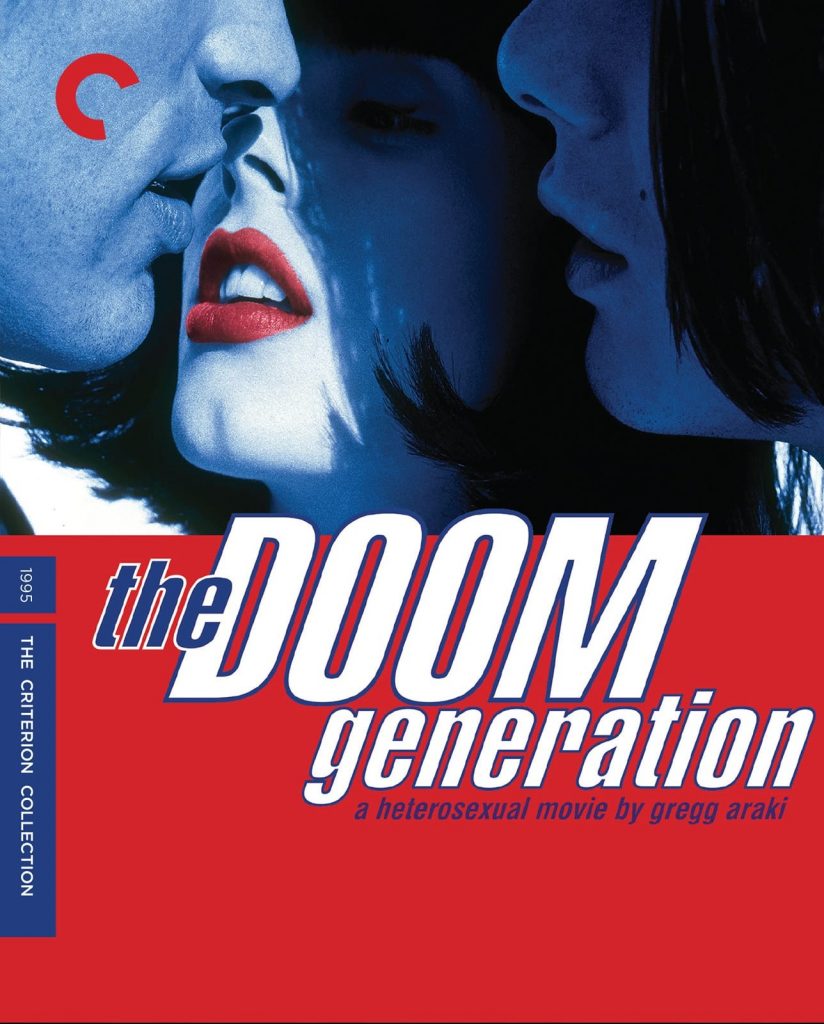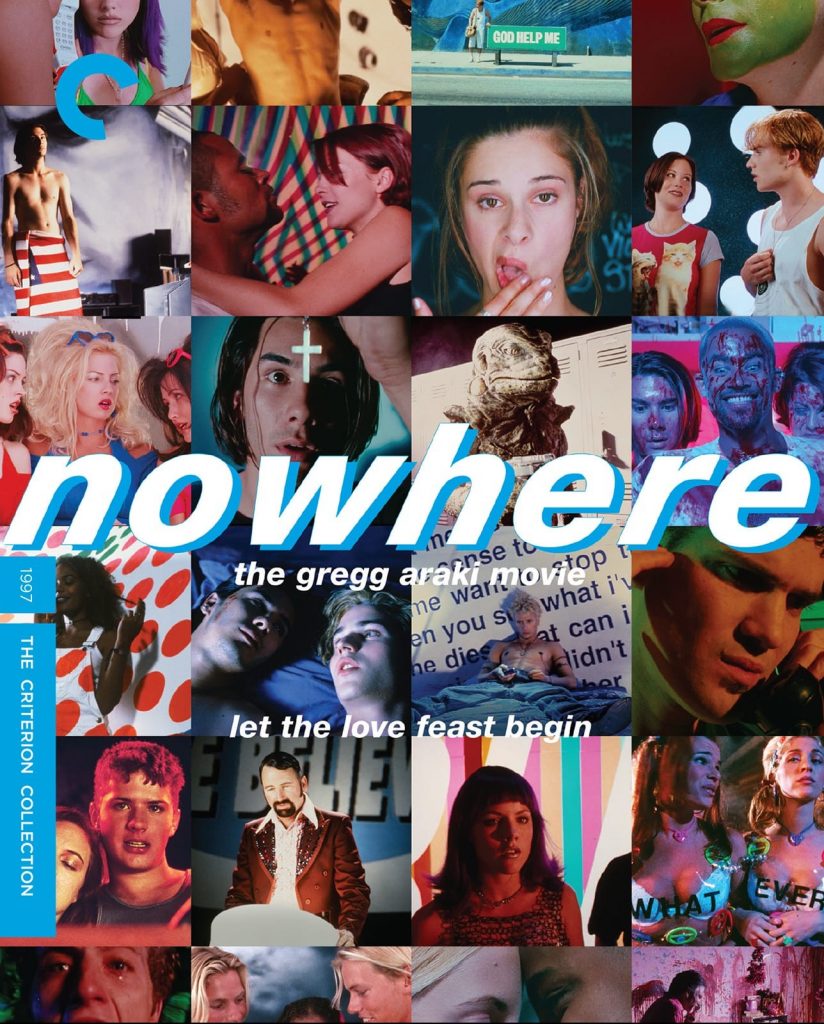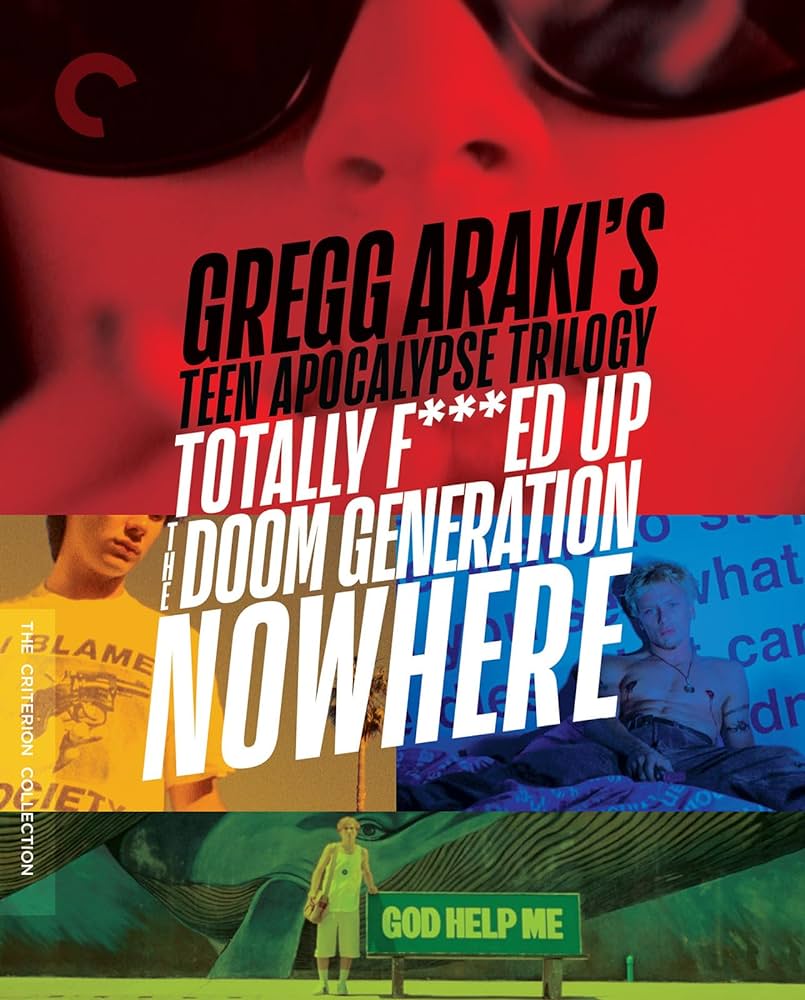Criterion Collection, in collaboration with Strand Releasing, bring for the first time in high definition in North America, Gregg Araki’s crazy, influential Teen Apolcalypse Trilogy, comprised of the films Totally F***ed Up, The Doom Generation and Nowhere. It’s been a long time coming, so let’s dig in!

Totally F***ed Up from 1993 follows the lives of several gay teenagers as they wade through the unique problems of being LGBTQ in a straight world. Andy (James Duval) is something of a nihilist on the surface, constantly spouting off about how horrible life is, but he harbors a fragile romantic side that comes apart at the seems when a relationship doesn’t go the way he hoped. Steven (Gilbert Luna) is in love with Deric (Lance May), but they are driven apart by Steven cheating on Deric. Things only get worse when Deric is hospitalized by bigoted assholes. Tommy (Roko Belic) is flighty and constantly hops from partner to partner. As a kind of stabilizing force amidst all these somewhat broken people, Michele (Susan Behshid) and Patricia (Jenee Gill) are a pair of lesbians in a committed relationship who are already planning for the future.
Totally F***ed Up is often referenced as a key film in the New Queer Cinema movement of the early ’90s, which includes the likes of Derek Jarman and Todd Haynes, and while it certainly feels like a touchstone among that group of films with its frank depictions of sexuality and conversations on insecurity, fear of persecution and the AIDS epidemic, at the same time, it also feels of a piece with the early ’90s indie film scene, particularly the Richard Linklater film Slacker which was making the festival rounds around the same time as Totally F***ed Up (in fact, one of the extras is an interview between Araki and Linklater where they discuss crossing one another’s paths around this time). In some ways, much like Slacker, this is a messy and unfocused film, but Araki, who shot the film himself on 16mm with only a couple of crew members, manages to paint an interesting slice of life tapestry with characters we grow to care about. Duval as Andy in particular may cause heartbreak at witnessing his arc. And speaking of Duval, he’s probably the strongest actor of this bunch. Some of the cast feel a bit amateurish, but it’s clear that Duval has that quality that has allowed him to sustain a prolific film career which is still going to this day.

The Doom Generation from 1995 again stars James Duval, this time as Jordan White, a teenage burnout, and Rose MacGowan as his sexpot firecracker lady love Amy Blue. After crossing paths with an unstable drifter named Xavier Red a.k.a. X (Johnathon Schaech) and narrowly avoiding getting killed by a crazed convenience store clerk, only saved by X’s homicidal tendencies, they decide to hit the skip town on a sex and violence-fueled cross country road trip. Expect heavy drug use, very open sexual boundaries and dead bodies at every stop along the way.
The Doom Generation reminds me of the similarly caustic, nihilistic and stylized trashiness of Jon Moritsugu’s films like Terminal USA and Fame Whore. But where Moritsugu seeks to amuse and sow seeds of abstract absurdity and satire, Araki wallows in the lurid trashiness of a ’50s pulp noir taken to its most excessive tendencies. No one in Araki’s world behaves like a regular person. In fact, it’s hard to criticize X’s murderous desires at times given how extreme and hostile nearly everyone they come across reacts. Putting The Doom Generation into the context of the time in which it was released, it may on the surface come off as derivative of Natural Born Killers. But while Oliver Stone was preoccupied with media exploitation and sensationalism, Araki is more interested in how chaotic forces shape and mold destinies. The Doom Generation is a bold and confrontational film that seeks to dismantle Generation X from within. It does this through a creative and kinetic visual style that captures our color wheel characters in a whirlpool of senselessness. It’s a full throttle thrill ride through the gutters of America, and it’s a sight to behold.

Nowhere from 1997 follows the lives of a group of outsider teens in the Valley as they party, do drugs, sleep with each other and cross paths with aliens. James Duval yet again stars, this time as Dark, the focal point of many of these interactions, at a kind of crossroads with his bi-sexual girlfriend and unsure of what he really wants in life. We meet Dark’s girlfriend Mel (Rachel True) who is also dating Lucifer (Kathleen Robertson). We also meet several of their friends and acquaintances such as Cowboy, Ducky, Dingbat, Alyssa and Egg, who has a violent encounter with a star from Baywatch (Jaason Simmons playing a twisted version of himself). Meanwhile Dark saw aliens kill a bunch of valley girls and keeps trying to film the aliens to prove their existence. People hook up. People commit suicide at the behest of a televangelist (John Ritter). Dark eventually finds himself covered in blood in bed with a giant cockroach. That’s just how life goes in Nowhere.
Nowhere feels like the ideal culmination of Araki’s Teen Apocalypse trilogy, taking the more free-flowing narrative and tapestry of characters of Totally F***ed Up while blending it with the balls-to-the-wall anarchic aesthetic of The Doom Generation. For those looking for a more cohesive narrative, you might want to look elsewhere. But Araki has populated this film with such an eccentric and engaging group of people that the lack of narrative thrust is rarely missed. Araki’s Altman-goes-to-Hell approach allows him create a kaleidoscopic funhouse of misanthropes layered with a healthy dose of absurdity. Aliens have no business anywhere near this kind of film. And yet there they are, murdering Traci Lords, Shannon Doherty and Rose McGowan. And you know what, we don’t really care. Because the characters don’t really care. Dark is interested, but it’s rarely more than a passing fascination with him rather than a truly shocking phenomenon. The movie also has an unusually strong supporting cast of Gen X actors including Christina Applegate, Scott Caan, Mena Suvari, Ryan Phillipe, Denise Richards, Heather Graham and others. It also stacks the deck with small roles from industry veterans like Richard Leisure, Beverly D’Angelo, Eve Plumb and the aforementioned John Ritter. Heck, it’s even got Gibby Haynes of The Butthole Surfers in there (following up Araki’s casting of Perry Farrell of Jane’s Addiction in The Doom Generation). Nowhere is a messy and chaotic film, and I wouldn’t have it any other way.
The transfers for all three films are newly restored from original camera negatives (with a few scenes using interpositives) with scans personally supervised by Araki himself. All three look very good with The Doom Generation‘s and Nowhere‘s looking the best for a multitude of reasons. Totally F***ed Up was mastered in 2K from 16mm, so it is naturally going to look much rougher and grainier solely based on the source its drawing from, but it still looks very clean and well-represented for the age and quality of the source. Meanwhile both The Doom Generation and Nowhere really pop. Araki is a very visually heightened director who employs bold colors and diverse camera techniques to create a kind of pop art aesthetic, and both 4K transfers from the 35mm negatives look stunning. All three films employ a 5.1 surround audio track. Totally F***ed Up sounds a bit degraded just due to the quality of the source but overall comes across very clear even if it doesn’t leverage the rear channels very much. The Doom Generation probably benefits the most from the surround sound with its more overt action sequences. But Nowhere sounds very good too with it’s wall of characters and party scenes benefitting from the additional sense of immersion.
Criterion, in collaboration with Araki, has given us a heaping helping of tasty extras to chew on for hours. All three films include audio commentaries with director Araki and actor James Duval as well as assorted other actors from each of the three films. Nowhere in particular includes six additional members of the cast and the whole commentary really feels like old friends getting together and reminiscing at times. Araki is very well-versed on the behind-the-scenes details of each film to provide that angle as well. Overall, all three are very good commentaries well worth checking out if you want lots of anecdotes about making the films. We also get several interviews including the aforementioned discussion between Araki and Linklater as well as a dedicated conversation between Araki and Duval reminiscing about the trilogy and the impact it had on their careers and interviews between Araki and Gus Van Sant and Andrew Ahn as part of an Academy Museum of Motion Pictures Q&A session. The set also includes a 30-minute documentary “Designing the End of the World: Making the Teen Apocalypse Trilogy” focusing on the visual aesthetic of the films and includes interviews with various crew including cinematographers, production and set designers, hair and makeup, costume designers and others. The set even includes a video slideshow of The Doom Generation comic book. We also get a physical booklet including synopses of the films, a note from Gregg Araki and and essay by film critic and professor Nathan Lee. This is a great collection of extras that really covers all aspects of the films and is immeasurably improved by Araki’s close involvement in the process.
Gregg Araki is an electric filmmaker whose trashy, zero-fucks-given films have crashed their way into the Criterion Collection in magnificent splendor with beautiful transfers and a glorious bounty of extras. For those looking to explore the films of this visionary and influential director, look no further!

